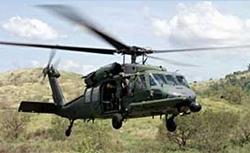Sat, Jul 05, 2003
Six Crewmembers Killed In Afghanistan
 The dark of night. A complex
refueling operation at high altitude. A pilot who may have suffered
a heart attack. All of these factors may have contributed to the
May 23 crash of a Sikorsky HH-60G "Pave Hawk" Special Operations
Helicopter in Afghanistan, according to a military report issued
Thursday.
The dark of night. A complex
refueling operation at high altitude. A pilot who may have suffered
a heart attack. All of these factors may have contributed to the
May 23 crash of a Sikorsky HH-60G "Pave Hawk" Special Operations
Helicopter in Afghanistan, according to a military report issued
Thursday.
In the Dark Of Night
The investigation, led by Brig. Gen. Gregory Power (USAF), found
that the accident occurred at 9,000 MSL in a mountainous area near
the Afghan town of Ghazni. The crew was airlifting two Afghan
children for medical care. It was just past dusk, according to the
report, when the Pave Hawk maneuvered for aerial refueling behind a
HC-130P tanker at a mere 350 ft. AGL. That's well below the 500
foot minimum required by the military.
While listing as the three primary causes the
rapid fall of night and the high altitude, the report also detailed
the autopsy performed on aircraft commander Lt. Col. John Stein.
Forensic experts concluded Stein suffered from 95 percent blockage
of his coronary artery.
"This raises the possibility that the aircraft commander may
have been undergoing angina (news - web sites) (chest pain) cardiac
arrhythmia (abnormal heart rhythm) or acute myocardial infarction
(heart attack) during the helicopter refueling or later in the
mishap sequence," the report said, as quoted by Reuters. However,
one Air Force medical witness told the investigating team that
Stein had no complaints about chest pains and had passed a physical
which included riding a stationary bicycle. The only way to find
out for sure during the flight medical would have been to
operate.
No Cause Determined
 The Air Force refused to issue a
primary determination in the accident. However, the investigation
report indicated that the Pave Hawk was trying to refuel as day
turned into night, rendering the flight crew's night vision goggles
less-than-effective.
The Air Force refused to issue a
primary determination in the accident. However, the investigation
report indicated that the Pave Hawk was trying to refuel as day
turned into night, rendering the flight crew's night vision goggles
less-than-effective.
"The terrain's high altitude ... combined with the 30-degree
bank during the refueling aircraft's climbing turn, made it
difficult to maintain the helicopter in the refueling position,"
the Air Force said in a statement. Local commanders will decide
what, if any, disciplinary action will be taken in the
incident.
More News
Decision Altitude (DA) A specified altitude (mean sea level (MSL)) on an instrument approach procedure (ILS, GLS, vertically guided RNAV) at which the pilot must decide whether to >[...]
Aero Linx: T-34 Association, Inc. The T-34 Association was formed in July 1975 so that individuals purchasing then military surplus T-34As had an organization which would provide s>[...]
As He Released The Brakes To Begin Taxiing, The Brake Pedals Went To The Floor With No Braking Action Analysis: The pilot reported that during engine start up, he applied the brake>[...]
“Legislation like the Mental Health in Aviation Act is still imperative to hold the FAA accountable for the changes they clearly acknowledge need to be made... We cannot wait>[...]
Also: IAE Acquires Diamond Trainers, Army Drones, FedEx Pilots Warning, DA62 MPP To Dresden Tech Uni The danger to the flight training industry and our future pilots is clear. Dona>[...]
 ANN's Daily Aero-Term (12.08.25): Decision Altitude (DA)
ANN's Daily Aero-Term (12.08.25): Decision Altitude (DA) ANN's Daily Aero-Linx (12.08.25)
ANN's Daily Aero-Linx (12.08.25) NTSB Final Report: Piper PA-31T3
NTSB Final Report: Piper PA-31T3 Aero-News: Quote of the Day (12.08.25)
Aero-News: Quote of the Day (12.08.25) Airborne-Flight Training 12.04.25: Ldg Fee Danger, Av Mental Health, PC-7 MKX
Airborne-Flight Training 12.04.25: Ldg Fee Danger, Av Mental Health, PC-7 MKX




